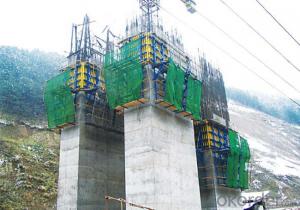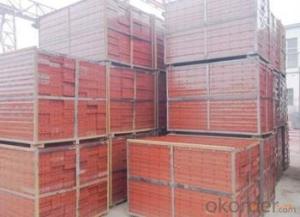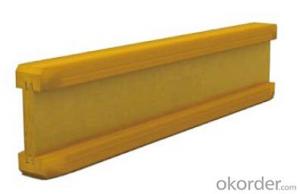Climbing Bracket CB-210 for formwork and scaffolding system
- Loading Port:
- Tianjin
- Payment Terms:
- TT OR LC
- Min Order Qty:
- 50 m²
- Supply Capability:
- 1000 m²/month
OKorder Service Pledge
OKorder Financial Service
You Might Also Like
Climbing Bracket CB240 & CB210
They are framework brackets for supporting large-area wall formwork.
Typical applications for the CB240&CB210 are pier and column/shear wall/core walll/ in the
building.
CB210 has smaller size than CB240, it will be cost effective in some condition.
Characteristics:
◆ High bearing capacity
The high loading capacity of the brackets allow very large scaffold units. This saves the number
anchor points required as well as reducing climbing times.
◆ Simple moving procedure by crane
Through the strong connection of formwork together with the climbing scaffold, both can be moved
as a single climbing unit by crane. Thus valuable time-savings can be achieved.
◆ Fast striking process without a crane
With the retrusive set, large formwork elements can also be retracted quickly and a minimum of
effort.
◆ Safe with work platform
The platforms have assembled firmly with bracket and will be climbing together, without scaffolding
but can work safely in spite of your high location.
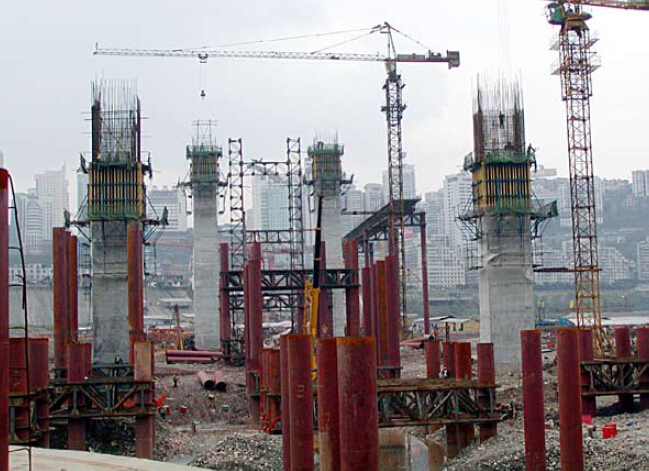
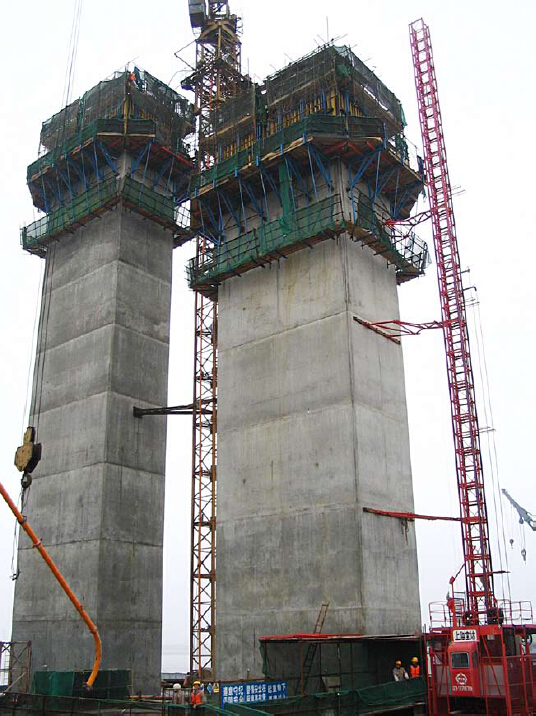
- Q: How does steel formwork impact the overall cost of a construction project?
- Steel formwork can have a significant impact on the overall cost of a construction project. While steel formwork may have a higher initial cost compared to traditional timber formwork, it offers several advantages that can result in cost savings in the long run. Firstly, steel formwork is more durable and has a longer lifespan than timber formwork. It can withstand multiple uses without significant wear and tear, reducing the need for frequent replacements. This longevity of steel formwork eliminates the costs associated with purchasing new formwork materials for each construction project, resulting in long-term savings. Moreover, steel formwork provides superior strength and stability, allowing for larger and more complex construction designs. This enhanced structural integrity can reduce the need for additional support systems, such as props or scaffolding, which can add to the overall costs of a project. Additionally, steel formwork can be easily customized to fit different shapes and sizes, minimizing wastage and optimizing material usage. Furthermore, steel formwork offers faster assembly and dismantling times compared to timber formwork. The modular nature of steel formwork allows for easy installation and removal, reducing labor costs and increasing productivity. The shorter construction cycle facilitated by steel formwork can lead to significant time savings, enabling early project completion and reducing financing costs. Another cost-saving aspect of steel formwork is its reusability. Steel formwork can be dismantled, cleaned, and reused in subsequent projects, minimizing the need for new formwork materials. This not only reduces the material procurement costs but also decreases waste generation and environmental impact. However, it is important to note that the cost impact of steel formwork will vary depending on the specific project requirements and regional factors such as material availability and labor costs. Therefore, a detailed cost analysis considering all these factors is crucial in determining the overall cost-effectiveness of steel formwork for a construction project.
- Q: What are the different finishes available for steel formwork?
- There are several different finishes available for steel formwork, depending on the desired appearance and functionality of the final product. Some of the most common finishes include: 1. Smooth finish: This is the most basic finish option, where the steel formwork is left as is without any additional treatment. It provides a clean and simple appearance, but it may not be suitable for applications where increased durability or corrosion resistance is required. 2. Galvanized finish: Steel formwork can be hot-dip galvanized, which involves coating the surface of the steel with a layer of zinc. This finish provides excellent corrosion resistance, making it suitable for outdoor applications or structures exposed to moisture. 3. Powder coating: Powder coating is a popular finish option for steel formwork. It involves applying a dry powder to the surface of the steel and then baking it in an oven to create a durable and attractive finish. Powder coating provides excellent corrosion resistance and can be customized to achieve different colors and textures. 4. Epoxy coating: Epoxy coatings are commonly used in industrial settings where chemical resistance is required. These coatings create a protective layer on the steel formwork, making it resistant to chemicals, abrasion, and moisture. Epoxy coatings can also be customized with different colors and textures. 5. Paint finish: Steel formwork can be painted with various types of paint, such as enamel or latex, to achieve a desired appearance. Paint finishes provide some level of corrosion resistance, but they may not be as durable as other finish options. It is important to consider the specific requirements and conditions of the project when selecting the appropriate finish for steel formwork. Factors such as the intended use, exposure to elements, and aesthetic preferences should be taken into account to ensure the desired outcome.
- Q: Can steel formwork be used in corrosive environments?
- Corrosive environments can indeed accommodate the use of steel formwork. Steel is renowned for its durability and strength, making it a suitable option for construction purposes even in corrosive surroundings. However, certain precautions must be taken to ensure its long-term performance. One common precautionary method involves the application of protective coatings such as epoxy or zinc to the steel formwork. These coatings create a barrier that prevents direct contact between the steel and corrosive elements, thereby reducing the risk of corrosion. Another alternative is the utilization of stainless steel formwork, which possesses inherent resistance to corrosion due to its high chromium content. Regular maintenance and inspection are also imperative to promptly detect any signs of corrosion and take appropriate measures to address them. This could entail cleaning the formwork, repairing damaged coatings, or replacing heavily corroded sections. In conclusion, with the proper implementation of protective measures and regular maintenance, steel formwork can effectively withstand corrosive environments and offer a reliable and durable solution for construction projects.
- Q: What are the common design considerations for steel formwork in heritage buildings?
- When it comes to the design of steel formwork in heritage buildings, there are various factors that must be taken into account. These considerations aim to maintain the historical and architectural significance of the building while ensuring efficient construction processes. Some of the main design considerations for steel formwork in heritage buildings include the following: 1. Preservation of Historical Value: The primary objective when designing steel formwork for heritage buildings is to preserve and protect the historical elements of the structure. The design must respect the building's original architectural features, materials, and construction methods, while also ensuring that the formwork adequately supports the weight of the concrete during the construction process. 2. Structural Stability: The steel formwork design should provide sufficient support and stability to the structure during the pouring and curing of the concrete. It is crucial to consider the load-bearing capacity of the formwork and ensure that it can withstand the weight of the concrete, reinforcing bars, and construction equipment without causing any damage to the heritage building. 3. Flexibility and Reusability: Since heritage buildings often require restoration or repairs over time, it is essential to design the steel formwork in a way that allows for easy disassembly and reuse. This consideration ensures that the formwork can be removed without causing any harm to the building and can be used again for future construction projects. 4. Aesthetic Considerations: In heritage buildings, maintaining the original architectural aesthetics is of utmost importance. The design of the steel formwork should take into account the visual impact it will have on the structure. This may involve incorporating decorative elements or finishes that match the existing architectural style or using formwork that can be concealed or removed once the concrete is set. 5. Accessibility and Safety: The design of the steel formwork should consider the safety requirements for both construction workers and the general public. It should ensure safe access to different areas of the building during construction and minimize any potential risks or hazards associated with formwork installation and removal. 6. Environmental Considerations: Sustainable design practices should be considered when designing steel formwork for heritage buildings. This may involve using recycled or low-impact materials, minimizing waste generation, and implementing energy-efficient construction techniques. In conclusion, the design considerations for steel formwork in heritage buildings revolve around the preservation of historical value, structural stability, flexibility, aesthetics, accessibility, safety, and environmental sustainability. By addressing these factors, architects and engineers can ensure that the construction process respects the heritage value of the building while meeting modern construction standards.
- Q: What are the common safety guidelines when working with steel formwork in confined spaces?
- To ensure the well-being of workers involved in working with steel formwork in confined spaces, it is crucial to adhere to specific safety guidelines. Consider the following commonly recommended safety measures: 1. Thoroughly assess risks: Prior to commencing work in a confined space, it is imperative to evaluate potential hazards and risks associated with the task at hand. This evaluation should encompass the identification of dangers such as inadequate ventilation, limited access, or the presence of hazardous gases. 2. Ensure sufficient ventilation: Confined spaces often lack proper air circulation, which can result in the accumulation of toxic gases or oxygen deficiency. Before entering, verify that the area is adequately ventilated, and continuously monitor air quality throughout the task. 3. Utilize suitable personal protective equipment (PPE): Workers must always wear the appropriate PPE, which includes safety helmets, goggles, gloves, and respiratory protection as required. The specific PPE necessities may vary depending on the nature of the confined space and associated hazards. 4. Implement adequate lighting: Insufficient lighting in confined spaces can hinder visibility and compromise safety. To mitigate accidents, provide sufficient lighting to ensure clear visibility. 5. Establish proper entry and exit procedures: Clearly define entry and exit procedures for workers entering and exiting confined spaces. This should involve the use of appropriate signage, secure barriers, and the assignment of a responsible individual to monitor and control access. 6. Ensure effective communication: Establish a reliable communication system between workers inside and outside the confined space. This can be achieved through the use of two-way radios, hand signals, or other means of communication to prevent isolation and enable prompt assistance if necessary. 7. Regularly inspect equipment and formwork: Prior to commencing work, inspect the steel formwork and associated equipment for any damage or defects. Promptly address any issues to prevent accidents or structural failures. 8. Provide comprehensive training: Workers involved in working with steel formwork in confined spaces should receive thorough training on safety procedures, hazard recognition, emergency response, and proper equipment usage. Regular training updates should also be conducted to ensure workers remain knowledgeable about safety practices. 9. Establish an emergency response plan: Despite taking necessary precautions, emergencies can still occur. Develop an emergency response plan that outlines evacuation, rescue, and medical assistance procedures. Ensure all workers are familiar with the plan and conduct regular drills to practice these protocols. 10. Regularly review and update safety procedures: Continuously review and update safety procedures to incorporate new regulations, industry best practices, or lessons learned from previous incidents. Continuous improvement and monitoring of safety measures are vital to maintaining a safe working environment. Remember, working in confined spaces with steel formwork carries significant risks. By following these common safety guidelines and fostering a safety-conscious culture, the risk of accidents and injuries can be minimized, ensuring a safer working environment for all.
- Q: Can steel formwork be used for precast concrete beams with complex geometries?
- Yes, steel formwork can be used for precast concrete beams with complex geometries. Steel formwork provides high strength and flexibility, allowing it to be easily shaped and adjusted to meet the specific geometrical requirements of the precast concrete beams. This makes it a suitable choice for creating complex and intricate shapes during the precast concrete beam manufacturing process.
- Q: Steel formwork in the construction project, after the completion of concrete pouring, the wall surface from the powder seriously how to deal with?
- There is a problem with the ratio of the concrete itself.
- Q: Can steel formwork be used for both single-storey and multi-storey structures?
- Yes, steel formwork can be used for both single-storey and multi-storey structures. Steel formwork is a versatile and durable option that can withstand the pressures and loads associated with multi-storey construction. It provides a strong and rigid framework for pouring concrete, allowing for the construction of walls, columns, beams, and slabs in both single-storey and multi-storey buildings. Additionally, steel formwork offers several advantages such as ease of use, reusability, and high-quality finishes, making it an ideal choice for various types of structures.
- Q: How much time does it take to install steel formwork?
- The time it takes to install steel formwork can vary due to several factors, including project size and complexity, worker experience and skill level, and the availability of equipment and resources. On average, the installation process can range from a few hours to a few days. Smaller and simpler projects can be completed relatively quickly, whereas larger and more intricate projects may necessitate more time and effort. It is crucial to meticulously plan and coordinate the installation procedure, taking into account the number, size, and weight of the formwork panels, as well as the necessary support systems. Moreover, weather conditions and site-specific challenges can also influence the installation timeline.
- Q: Can steel formwork be used for elevated slabs?
- Yes, steel formwork can be used for elevated slabs. Steel formwork is a versatile and durable option for constructing elevated slabs. It provides a strong and rigid structure that can support the weight of the slab and any additional loads. Steel formwork also offers the advantage of being reusable, allowing for cost savings and efficiency in construction projects. Additionally, steel formwork can be easily adjusted and customized to meet specific design requirements, making it suitable for various types of elevated slabs. Overall, steel formwork is a reliable option for constructing elevated slabs due to its strength, durability, reusability, and versatility.
Send your message to us
Climbing Bracket CB-210 for formwork and scaffolding system
- Loading Port:
- Tianjin
- Payment Terms:
- TT OR LC
- Min Order Qty:
- 50 m²
- Supply Capability:
- 1000 m²/month
OKorder Service Pledge
OKorder Financial Service
Similar products
Hot products
Hot Searches

